- Welcome
- Buildings
- Archives
- Cemeteries
- Vital Records
- Maps
- Join
The Canaan Historical Society works to preserve the history of Canaan, New Hampshire and to educate the community about Canaan’s past.
Canaan Village History
Early Days
Before the Great Northern Railroad came to Canaan in 1847, the Village area was known as East Canaan. Most of the Village was originally part of the Hutchinson family farm. Mr. Levi Hutchinson, a hatter by trade, brought his wife and three children to Canaan from Pembroke, New Hampshire. His house, built by Asa Whittier, was where the post office is now located. In 1841, Levi’s son Richard married Mary Sanborn and gained possession of his father’s farm.
In 1844, plans were made to lay tracks for the railroad from Concord, New Hampshire to White River Junction, Vermont. For two years, workers blasted through ledges at Rams Head and the Summit to lay the rail for the railroad. On November 17, 1847 the first train passed through Canaan, with the Honorable Daniel Webster on board. Richard Hutchinson’s offer of land was quickly accepted by railroad officials and a rail station was built at the present site of the Village Washtub. The first station agent, Caleb S. Putnam, had been a driver on the stage route. He kept his job as Canaan's Station Agent for over twenty years.
Once the railroad began operation, the Village grew quickly. Main Street, which ran from the train station to the present home of Brian and Betty Hayes, was laid out in 1848. Today, the portion of this road between Auto Ware and Neily’s Store is known as Depot Street. Mechanic Street, laid out in 1853, was originally named Willow Street and ran from the Veteran’s Memorial to the Square. Parker Street, also laid out in the 1850s, was named for Freeman S. Parker who built the house now owned by Mrs. Stacia Ballou. The Methodist Church was completed in 1861 and a new school was built on School Street. By 1860, the Village had shops for shoes, tin, woodworking, and harnesses. There was a hotel, a blacksmith, and a wheelright. The brickyard was on the site of Marvin Rocke’s home. The Village had become the Town’s trade center.
The ease of passenger rail made Canaan an ideal vacation spot for tourists who enjoyed access to Cardigan Mountain and Hart’s Pond (Canaan Street Lake). The “Ski Train” brought winter sports enthusiasts to town in the 1930s and 40s.
Fire, Flood, and Hurricane Shape the Village.
By 1918, Canaan had witnessed four floods and two tragic train wrecks. For the Village, however, the worst was yet to come. On the morning of June 2, 1923, a call came in concerning a fire in a haymow at the Stephens home on School Street. Within two hours, the entire business district, 48 homes and businesses, had been destroyed. The townspeople were resilient, though, and moved quickly to rebuild. Twenty two buildings were replaced within a single year. Trees were planted along the roadways soon after the fire and the Town Green, once the site of private homes, was formed. The four corners at the Village center were built up as stores and businesses.
In 1938, another disaster struck in the form of a hurricane. More recently, the decline of passenger rail and growth of Rte 4 affected the shape of the town as well. In the 1970s the large graceful trees along Depot Street began to die of Dutch Elm disease. The Canaan Inn burned in 1977. A wildly popular rock concert in the 70s drew 20,000 fans to the old fairgrounds. It proved so disruptive to the Village that the Town adopted an ordinance to require a permit for large outdoor musical events. In the 1980s there was another flood. Through it all, Canaan Village survived — a testimony to the townspeople who refused to give up in the face of adversity.
Information provided by Donna Zani Dinkerton, Canaan Town Historian.
Be sure to visit the Heritage Link to find many more photos and resources on Canaan's History!
Do you have a memory of Canaan Life you would be willing to share? Have a suggestion of someone we should record? Please contact Laura Bicknell at lbicknell@canaannh.org or 523-4501 ext. 108 to be put in contact with a Canaan Museum Curator!

The Canaan Academy Building, site of the Museum as seen from the tower of the Canaan Meeting House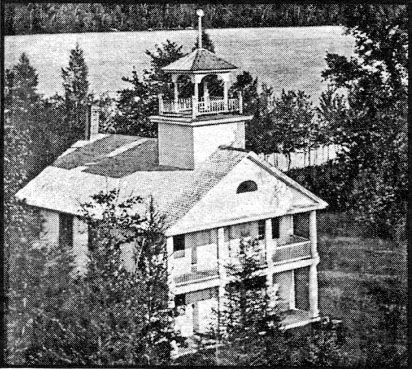
It was the Canaan Planning Board that drew up the article establishing a Canaan Museum, which was adopted by the March 1961 Town Meeting.
The Museum originated on the second floor of the Academy building on Canaan Street. It opened Saturday, August 19, 1961 with an exhibit of pictures, antique furniture and other items of historical significance. During the Bicentennial weekend more than 30O people attended the opening.
Medora Nutter and Martha Stevens were Co-Chairman for the event. Others who were asked to be on the committee of curators were: Katherine Gordon, Pauline Barney, Constance Burbnk, Margaret Eggleston, Karl Nyhus, Joseph Chandler, Col. Philip M. Whitney and Elsie G. Crocker. Elsie, a descendant of Canaan’s second settler, Thomas Miner, was the first president of the newly formed association.
Through the years many changes have taken place. After the library relocated to Canaan Village in 1978, the Museum moved to its present location in Academy Hall. The building was closed in 1979 and again in the mid-1980’s due to foundation work and other various repairs. When the organization celebrated its Grand Re-Opening, people gave freely of their family possessions to be displayed in the town’s museum.
As the Society’s collection increased, it became, necessary, to renovate the old kitchen and back room of the Museum building for the much-needed space. The kitchen was used for years by the Ladies Church Aid on Canaan Street to prepare meals for Town Meeting and numerous other events. This is now the Museum’s History Room. The walls are filled with pictures, articles and other tidbits of Canaan’s past.
The newly finished back room, which once housed a unique “three-holer”, now contains old School desks that predate the Civil War. They were used in this building when it was known as Canaan Union Academy.
The Museum also has the bells from the Canaan High and Canaan Center School, the bench from the Canaan Railroad station, the movie projectors, used in the Town Hall Theatre, a century-old accordion owned by Hiram Blaisdell and a display of science equipment purchased in the 1850s at a cost of $850.00. These are only a few of the articles that comprise the Historical Society’s outstanding collection of Canaan’s memorabilia.
The Canaan Historical Society is working to preserve
The George Kimball House
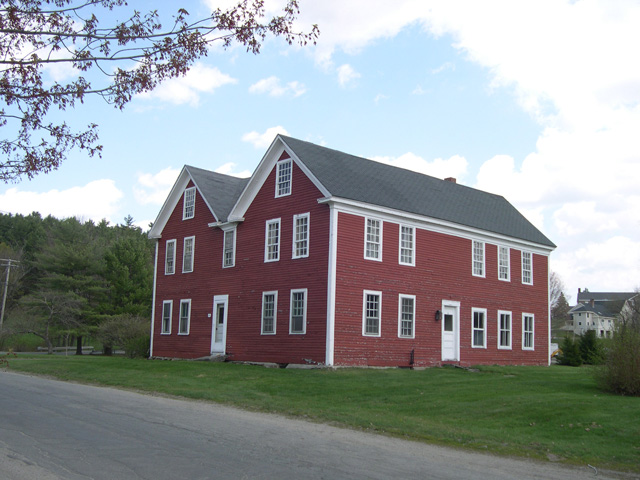
When Noyes Academywas established in Canaan in 1834, it was the first upper level, coed integrated school in the country. Imagine what life was like at the time, how blacks were treated, how they lived, what jobs and education were available to them. Think of parents who dared to send their young children from New York and other cities to lily-white New Hampshire, a strange place, at a strange time, and a huge risk for all.
The bravery of the parents was impressive. After a horrendous trip emphasizing their low social status, the students arrived in Canaan. There they found warm and caring people who believed in the education of blacks and whites. All students were treated the same. They enjoyed months of equality, both in the classroom and in the social environment.
Anti-abolitionists destroyed the school and the students were sent back to their homes, but the short time they had at Noyes Academy was seared in their memories and those memories sustained them. What they learned, academically and socially, led a number of the students to further advanced schooling and long careers of service.
Read about the people associated with Noyes Academy and the George Kimball House: Incorporators and Trustees Students Instructors Town Officials Lawyers Supporters Opponents
George Kimball was a trustee of the academy and hosted the male students in his house during their stay at the school. His house is the remaining connection that we have to Noyes Academy and its illustrious students. The Historical Society hopes to save the George Kimball House to preserve the memory of the Academy's students and incorporators.
You can also review the house plans. For additional information, contact CLTownsend@comcast.net
Be sure to visit the Heritage Link to find many more photos and resources on Canaan's History!
Do you have a memory of Canaan Life you would be willing to share? Have a suggestion of someone we should record? Please contact Laura Bicknell at lbicknell@canaannh.org or 523-4501 ext. 108 to be put in contact with a Canaan Museum Curator!
*****
History of Canaan
- On July 9, 1761 His Excellency Benning Wentworth first issued the first charter for the Town of Canaan. Legend has it that the first settlers, John Scofield, his wife and four children, made it their home in December 1766.
- Arthur Walworth has contributed excerpts from the diaries of his great-grandfather, James J. Walworth, who was born on South Road in Canaan in 1809. His great-grandfather lived in Canaan for the first 20 years of his life and we have the J. J. Walworth diary entries for the last year before he moved to Boston in 1829.
- The Canaan Union Academy was established after the closing of Noyes Academy. The Catalogue for the 1839 school year lists many names familiar from Noyes Academy. The school closed after several years and was reopened in 1853, after "enlarging and refitting the Academy Building". The 1853 Canaan Union Academy Catalogue lists 65 male and 45 female students.
- The Gazetteer of Grafton County, N. H. was published in 1886. It was one of many county gazetteers that were published in the period and like most, it contains historical descriptions of each town.The Canaan chapterincludes descriptions of businesses and some genealogy as well as town history. A town map is included and some of the residences are keyed to it.
- The New Hampshire Patriot published an article The Canaan And Cardigan. A Delightful Resort and a Grand Old Mountain, on July 15, 1886. The delightful resort that it describes is the newly opened Jerusalem Spring House and the grand old mountain is, of course, Mount Cardigan.
- Despite some historical inaccuracies, A New England Hill Town — 1800–1850, by Amos Noyes Currier, provides an interesting sketch of life in Canaan during the first half of the 19th century. It was written in 1895.
- The book length History of Canaan, N. H. is a wonderful telling of the history of the town and its people, published in 1910 by William Allen Wallace. Reprints are available in hardcover from the Canaan Historical Society. Buy a copy and enjoy the heft of a good book to read as you sit by the fire. To order a copy, call Donna Zani-Dunkerton, the Society’s Historian and Corresponding Secretary, at (603) 523-7960. A scanned copy of most of the History of Canaan, N. H. is available online. It can be seen at History of Canaan
- Historian Ned Smith prepared Canaan Bicentennial 1761 - 1961 for the Town's 200th anniversary. This wonderful resource adds information about the terrible train accident in September 1907, the fire that destroyed most of Canaan Village in June 1923, the hurricane of September 1938, as well as recapturing the years described in Wallace's History. This is a large pdf file which may take a while to download.
- Insight Magazine published a nice short History of Canaan in its Spring 1983 issue. It was written by Margo Moran (now Margo Taussig Pinkerton), a descendant of one of the town’s earliest settlers and a town resident at the time. She now lives in North Carolina but returns to the home of her ancestors several times a year. She teaches photo workshops here and overseas under the name Barefoot Contessa Photo Adventures.
- The area that is now downtown Canaan was developed as Canaan Village when the railroad came through town in 1847.
Photographs of The Canaan Train Wreck, The Canaan Village Fire, The Great Hurricaine, The Flood after the Hurricane and the Shaker Bridge document events during the last century. - Take the Canaan Street Historical Walking Tour to learn about the many historic locations in Canaan’s Historic District.
- Canaan has many discontinued roads, that the Town voted to make subject to gates and bars in the early and mid 1900's.
- A graph of Canaan population records shows our population history.
- Stories from the Canaan Reporter on "The Trainwreak of 1907" and the "Grand Opening of Canaan Drugstore".
- Postcards
- Paintings:
Be sure to visit the Heritage Link to find many more photos and resources on Canaan's History!
Do you have a memory of Canaan Life you would be willing to share? Have a suggestion of someone we should record? Please contact Laura Bicknell at lbicknell@canaannh.org or 523-4501 ext. 108 to be put in contact with a Canaan Museum Curator!
Canaan Cemeteries
Researchers interested in a particular family may find it helpful to use the search engine for the History of Canaan.
- Canaan Street Cemetery, Canaan Street
- Wells Cemetery, Canaan Street
- West Canaan, South Road
- Sawyer Hill, Sawyer Hill Road
- Blaisdell Cemetery, North Canaan; with Stone transcriptions
- King Cemetery, Dame's Gore, Dorchester; with Stone transcriptions
- West Farms, West Farms Road
- The Cobble, off South Road
- Birch Corner, Jerusalem Road
- Porter, Canaan Street
- Jones/Atwell, Dodge Road
- St. Mary's (DeCato/Catholic/Clark Hill Cemetery)
- Schofield, near Mud Pond Road
- Morse, Loch Haven Road, Enfield
- Pollard, off Gore Road, just over the line in Dorchester
Vital Records
This is the end of our records
Maps
Carey-Mathew-Lewis-Samuel
Map of New Hampshire - 1795
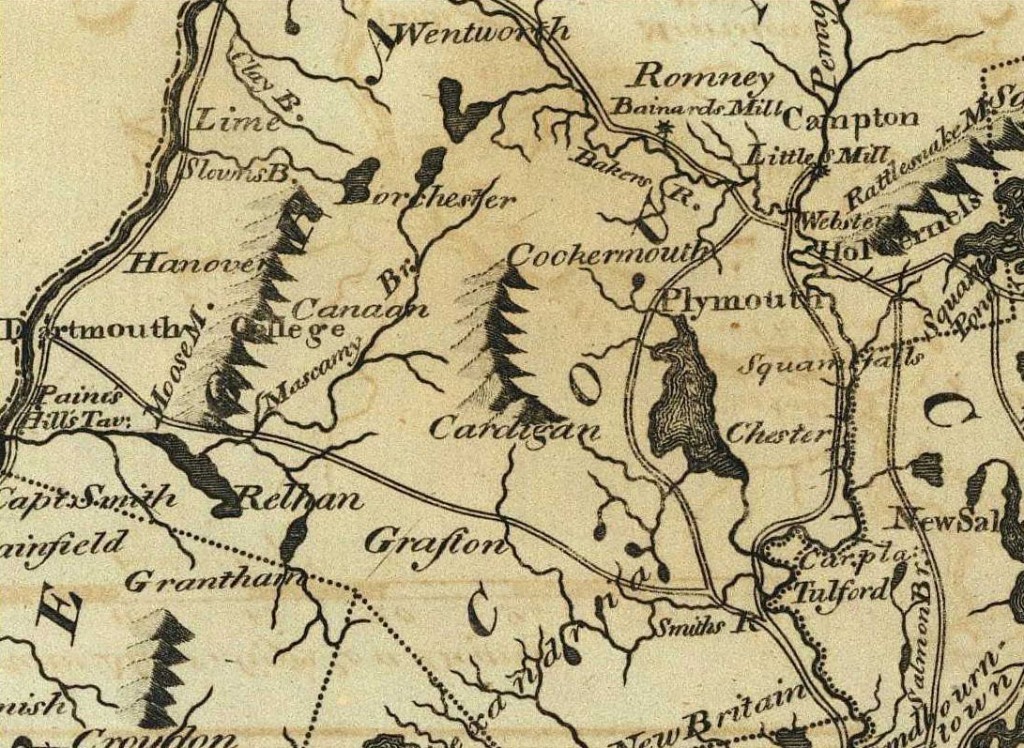
John Reid
Map of New Hampshire - 1796
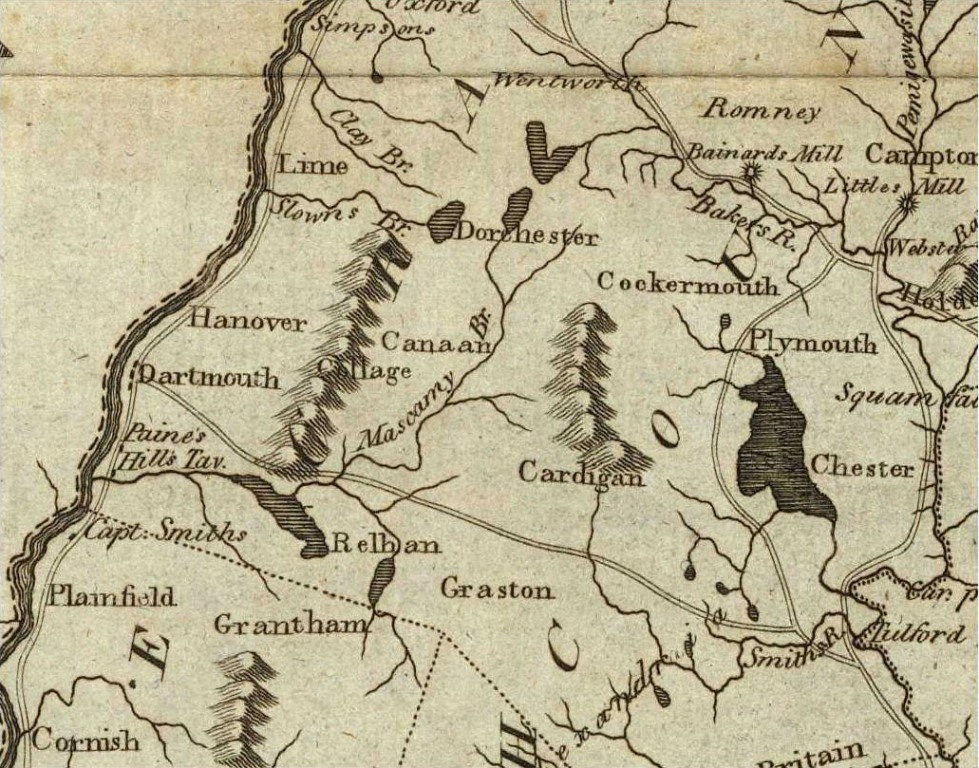
Philip Carrigain
Map of New Hampshire - 1816
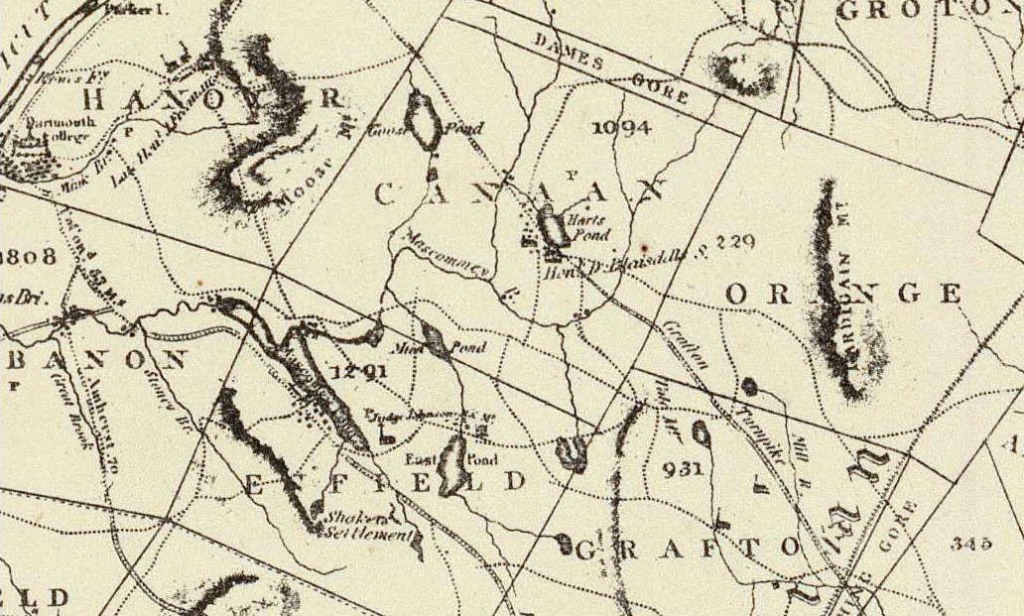
Edward Ruggles
Map of New Hampshire - 1817
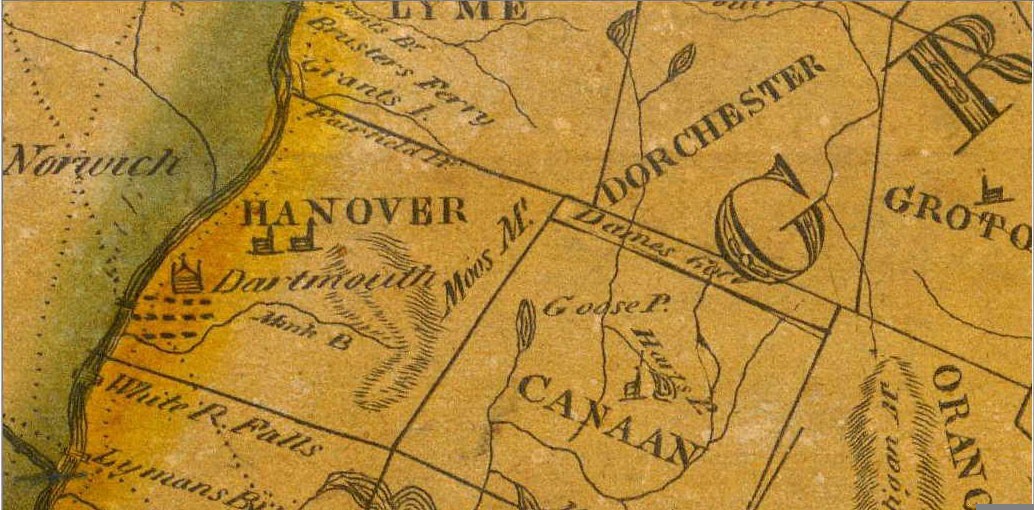
Henry Tanner
Map of Vermont and New Hampshire - 1836
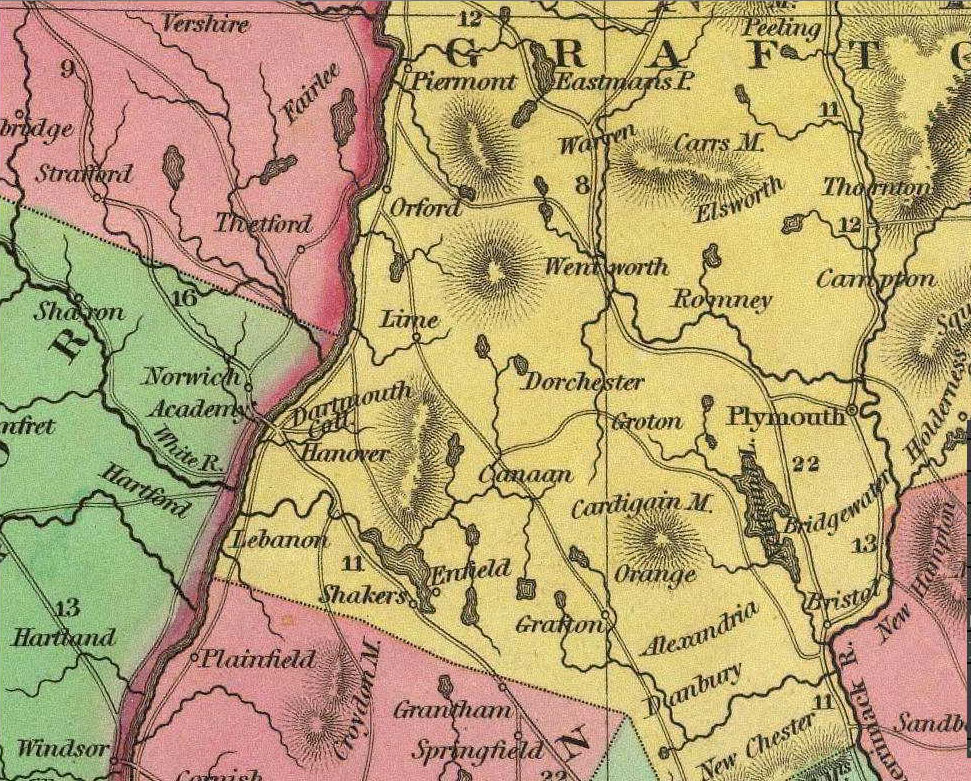
Thomas Bradford
Map of New Hampshire - 1838
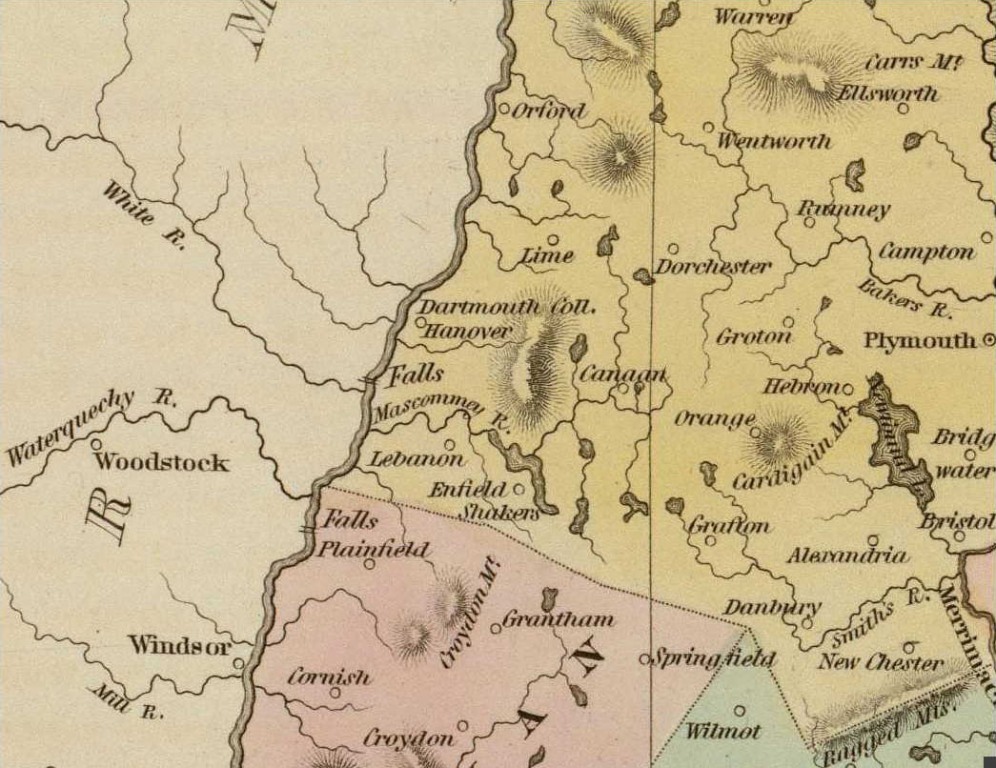
Sidney Morse
Map of New Hampshire - 1845
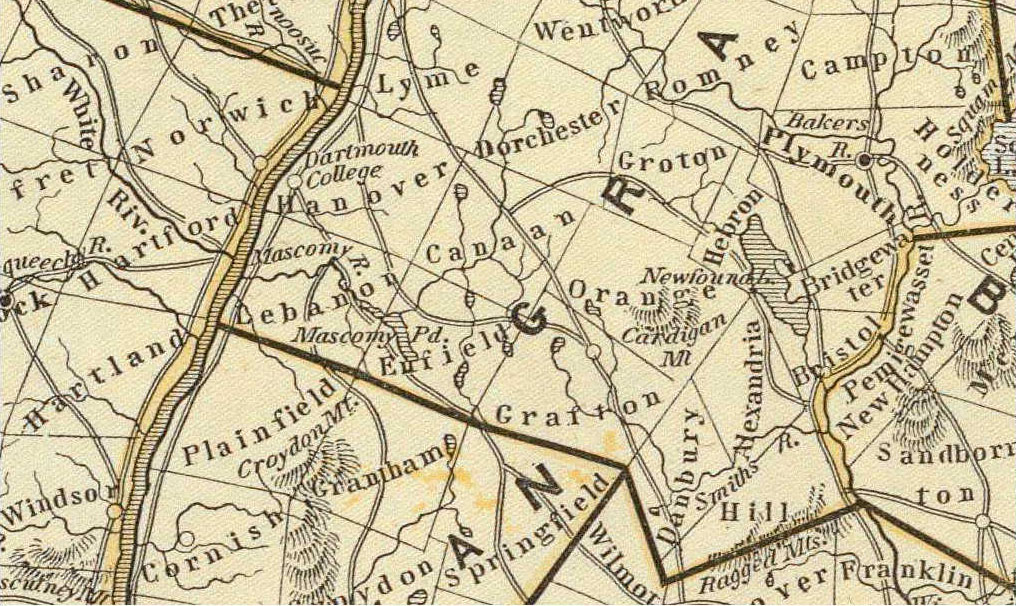
William C. Eaton
Map of New Hampshire - 1855
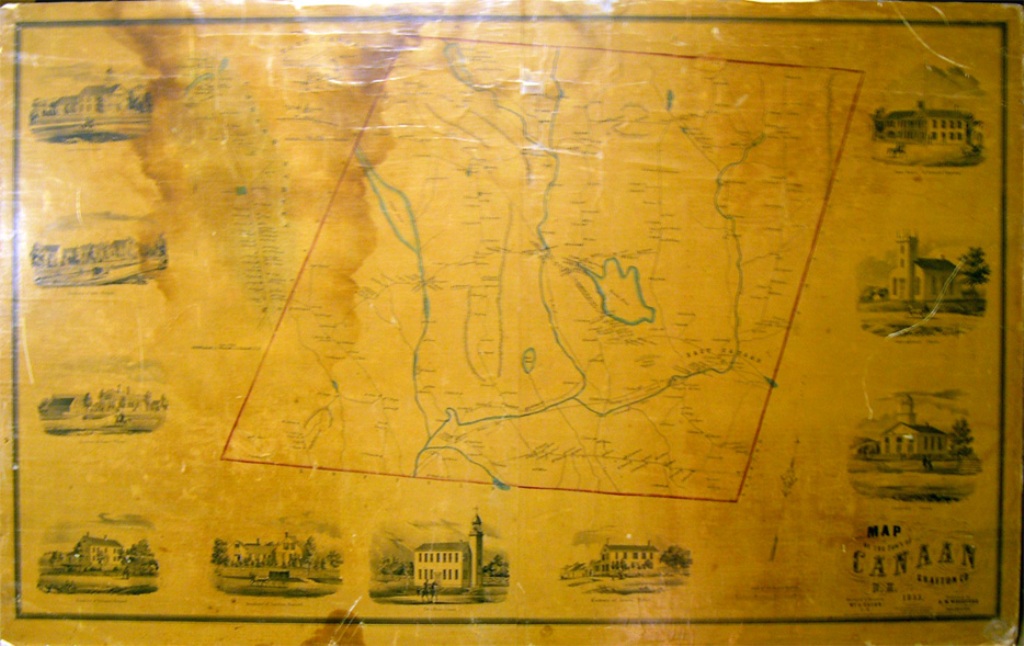
G.W. Colton
Map of New Hampshire - 1856
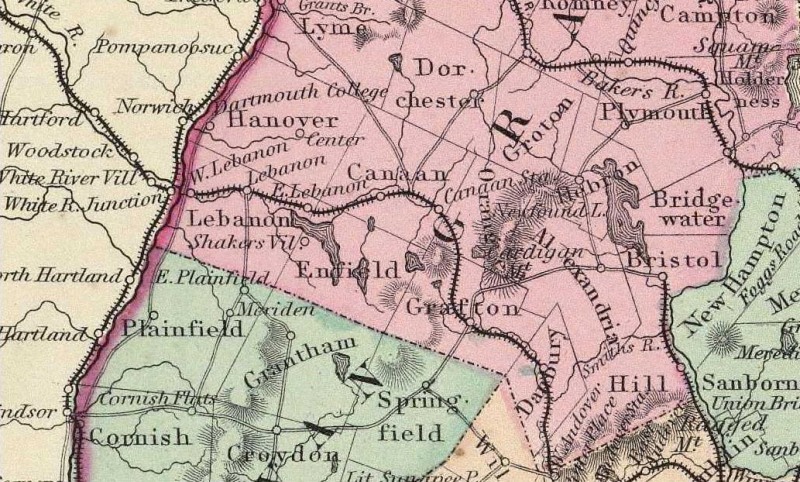
Topographical and Glacial Map
1878
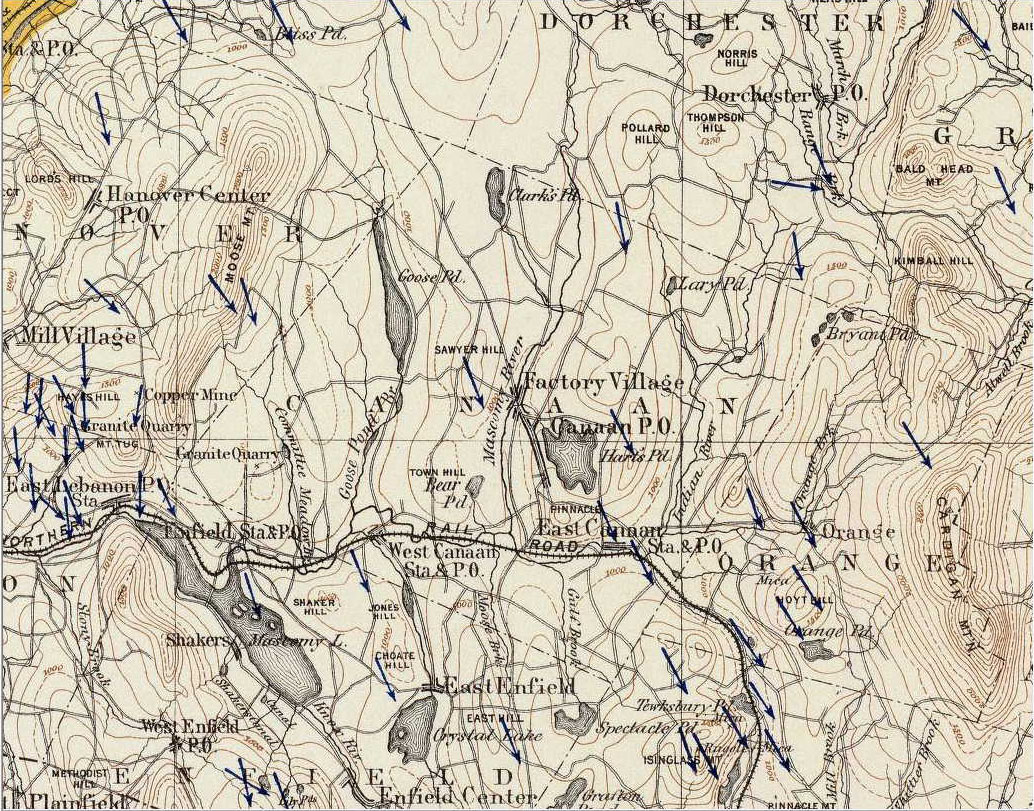
Canaan - Grafton County
1892
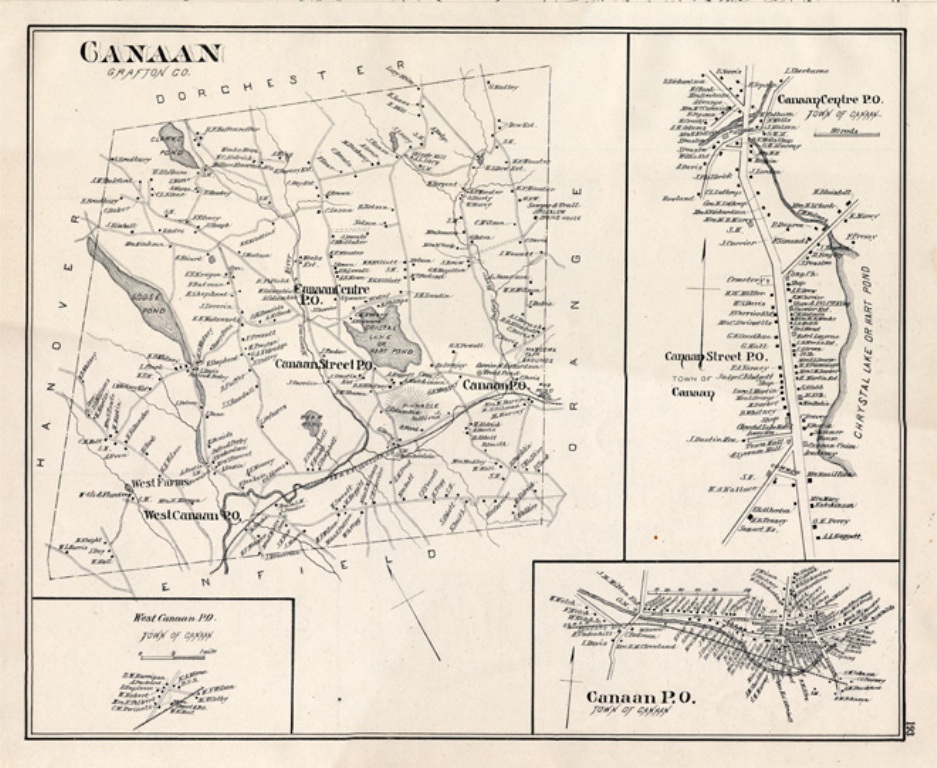
Rand McNally and Co.
Map of New Hampshire - 1897
![mj ,a[ 1897]](maps/rand-mcnally-and-co.-nh-1897.jpg)
Map of Canaan 2000
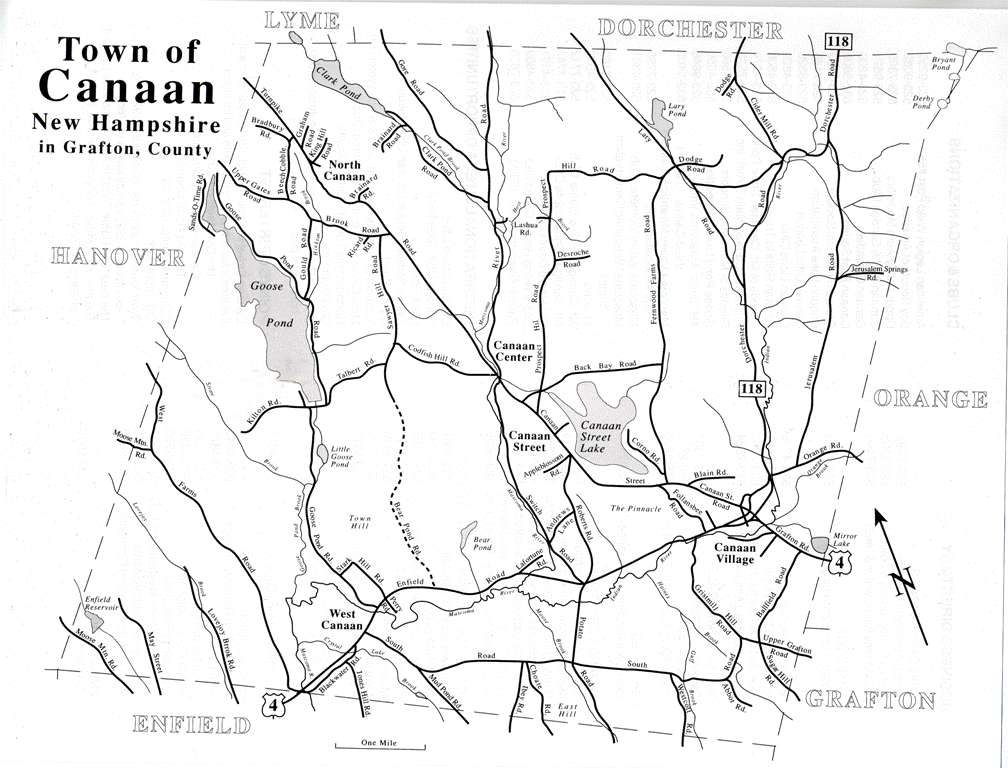
Join